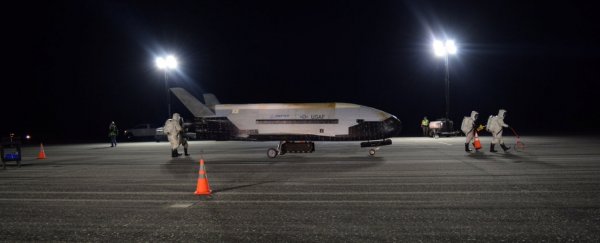The US Air Force's top secret, unpiloted space plane X-37B has arrived safely back on Earth after 780 days in orbit, the longest time a craft like this has ever spent in space.
Originally launched on 7 September 2017, the reusable vehicle landed once again on Sunday at NASA's Kennedy Space Center in Florida, after completing the fifth long-duration mission.
The first launch, which began in 2010, was only designed to fly for 270 days, but now, nearly a decade later, these Boeing-built space planes - of which there are at least two - have accumulated over 2,800 days in orbit.
"Today marks an incredibly exciting day for the 45th Space Wing," says commander Doug Schiess.
"Our team has been preparing for this event, and I am extremely proud to see their hard work and dedication culminate in today's safe and successful landing of the X-37B."
Exactly what these spacecraft are doing up there for years on end remains a mystery, and the little that's been revealed is sparking controversy.
A recent statement from the Air Force claims it is simply performing "risk reduction, experimentation and concept of operations" for reusable spacecraft technology; previous announcements have described tests for navigation and control, thermal protection systems, avionics, advanced propulsion systems, reentry and landing.
Some of the details, however, have experts concerned.
"This program continues to push the envelope as the world's only reusable space vehicle. With a successful landing today, the X-37B completed its longest flight to date and successfully completed all mission objectives," says the Air Force capabilities director Randy Walden.
"This mission successfully hosted Air Force Research Laboratory experiments, among others, as well as providing a ride for small satellites."
Jonathan McDowell, an astronomer at the Harvard-Smithsonian Center for Astrophysics, tweeted that these satellite deployments were not reported and that this could be the first time that "either the USA or Russia has blatantly flouted the Convention."
Ever since 1962, the United Nations has maintained a Register of Objects Launched into Outer Space to keep tabs on which countries bear responsibility for which space objects.
The statement that this @usairforce X-37 flight deployed small satellites is alarming, since the US has not reported those deployments in its UN Registration Convention submissions. This would be the first time that either the USA or Russia has blatantly flouted the Convention. https://t.co/mpLWuvsECV
— Jonathan McDowell (@planet4589) October 27, 2019
Well over 90 percent of satellites are registered, McDowell has found in his research, and this is usually done within one or two years of launching. Of all the unregistered satellites up there in orbit, however, the US is thought to be responsible for about a third of them, and this potential lack of compliance is anything but transparent.
There is, of course, a possibility that the US government just hasn't gotten around to registering these new satellites, but McDowell says that seems unlikely given what he knows.
"Top secret (even TS/SCI) does not trump international law and treaty," he argues.
As Earth's orbit gets busier and busier, regulation of space will no doubt become a massive point of contention. Not only is there fear of dangerous debris flying around our planet, there's also the problem of secret militarisation.
As we begin to navigate this new frontier, mysterious projects like these US Air Force missions will no doubt come under far greater scrutiny. The next launch for one of these space planes is set for sometime next year, and once again, the particulars are anyone's guess.
